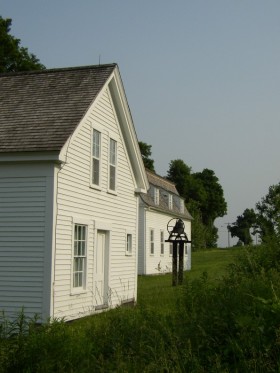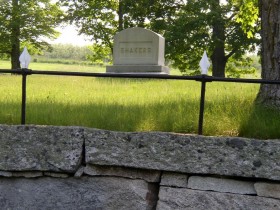Her memoir, Growing Up Shaker, provides a glimpse into life in the Sabbathday Lake community in New Gloucester. Many orphans, or children whose parents could not afford to care for them, were brought to Shaker communities instead of to orphanages. Carr arrived at the Sabbathday Lake Shaker community in the 1930’s when she was ten years old, along with her younger sister Ruth. Carr’s mother had already deposited three older children with the Shakers, and there seems to have been very little contact with the mother after that.
Carr describes with loving detail the women who mentored her, in particular Eldress Prudence and Sister Mildred Barker. The Shakers had high expectations for the children who lived in the community. They were expected to do their share of the work, attend school and practice the Shaker faith. Carr paints a picture of herself as a slightly rebellious youth who grew to love the Shaker way of life. She was the only one of her siblings who chose to sign a covenant and become a full fledged Shaker as an adult.
Her detailed account of life in the religious community, as well as her colorful anecdotes about some of the more well known Shaker leaders, including Eldress Prudence and Sister Mildred, give the reader an insider’s view into the very human nature of the members of the religious sect – such as Prudence enjoying a banana split at Woolworth’s when she made her weekly sales trips to Portland.
The Shakers embrace new technology and are fully integrated into the community that surrounds them. As a result, Carr’s book gives rare insight into life in rural Maine during the depression; it also gives testament to the sacrifices of every citizen during World War II by describing the effect of food and gas rationing on both the Shakers and their neighbors, and through the loss of Carr’s brother Herbert in the days after D-day.
Many young people who grew up among the Shakers chose to leave the community once they became adults. Carr describes her own sense of loss as her sisters and friends left one by one. Her own spiritual life matured as she did and she chose to remain. She eventually became the leader of the Shaker community in New Gloucester.
The Shakers provided a safe and secure home for many children whose homes and families were ravaged from the Civil War until the 1960’s. Sister Frances Carr’s memoir is an important record of what life was like for children like her as well as a detailed source of information of Shaker life. As of this writing in 2007, Sister Frances Carr is the last living female Shaker; there is one male Shaker as well. They both live at Chosen Land at Sabbathday Lake in New Gloucester.
Carr was interviewed by Stephanie Glatt who asked her how she wanted to be remembered. Carr said, “As a Shaker who, through difficult and good times, endeavored to live true to the vows that I made to uphold Shakerism, to pray for its continued existence.”
Additional resources
Carr, Sister Frances A. Growing Up Shaker. Sabbathday Lake, Me. The United Society of Shakers, 1994.
Carr, Sister Frances A. Shaker Your Plate: Of Shaker Cooks and Cooking. Sabbathday Lake, ME: The United Society of Shakers, 1985.
Glatt. Stephanie. Interview with Sister Frances Carr (Shaker Library Archive, BX9793, G5C3), part 1, copy 1, 103.
Text Contributed by Donna Olsen, Portland, Maine, 2008.



